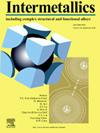硅对Cu-Ni-Si(-Mn)合金中非均质金属间化合物相形成的影响
IF 4.8
2区 材料科学
Q2 CHEMISTRY, PHYSICAL
引用次数: 0
摘要
本研究探讨了硅在Cu-Ni-Si(-Mn)合金中异相金属间化合物相的形成和演化过程中的作用。Si在晶内和晶界析出行为中都起着关键作用。Si含量的增加显著提高了晶内δ-Ni2Si相的体积分数和尺寸。此外,它还促进了晶界的形态变化,增加了晶界析出相的长径比,使其在含锰合金中转变为薄的薄膜状g相组织(Mn6Ni16Si7)。虽然晶界相的总体体积分数保持相对稳定,但这些si诱导的形态变化改变了晶界特征并影响了力学性能。在无锰Cu-Ni-Si合金中,较高的Si含量导致晶界δ-Ni2Si析出物变粗,强度和塑性下降。相比之下,在含锰合金中,即使Si含量增加,晶界g相保持稳定而不会变粗,这有助于保持延展性(~ 10%)并提高整体力学性能。这些发现强调了Si是通过控制金属间相形成来定制Cu-Ni-Si(-Mn)合金微观结构和优化力学性能的关键元素。本文章由计算机程序翻译,如有差异,请以英文原文为准。
Silicon effects on the formation of heterogeneous intermetallic compound phases in Cu-Ni-Si(-Mn) alloys under homogenization treatment
This study investigates the role of silicon in the formation and evolution of heterogeneous intermetallic compound phases in Cu-Ni-Si(-Mn) alloys subjected to homogenization treatment at 980 °C. Si plays a critical role in both the intragranular and grain boundary precipitation behavior. An increase in Si content significantly enhances the volume fraction and size of intragranular δ-Ni2Si precipitates. Furthermore, it promotes morphological changes at the grain boundaries, increasing the aspect ratio of boundary precipitates and transforming them into thin, film-like G-phase structures (Mn6Ni16Si7) in Mn-containing alloys. While the overall volume fraction of grain boundary phases remains relatively stable, these Si-induced morphological changes alter the grain boundary characteristics and impact mechanical performance. In Mn-free Cu-Ni-Si alloys, higher Si content leads to the coarsening of grain boundary δ-Ni2Si precipitates, degrading both strength and ductility. In contrast, in Mn-containing alloys, the grain boundary G-phase remains stable without coarsening, even with increased Si content, which helps retain ductility (∼10 %) and enhances overall mechanical properties. These findings highlight Si as a key element in tailoring microstructures and optimizing the mechanical performance of Cu-Ni-Si(-Mn) alloys through control of intermetallic phase formation.
求助全文
通过发布文献求助,成功后即可免费获取论文全文。
去求助
来源期刊

Intermetallics
工程技术-材料科学:综合
CiteScore
7.80
自引率
9.10%
发文量
291
审稿时长
37 days
期刊介绍:
This journal is a platform for publishing innovative research and overviews for advancing our understanding of the structure, property, and functionality of complex metallic alloys, including intermetallics, metallic glasses, and high entropy alloys.
The journal reports the science and engineering of metallic materials in the following aspects:
Theories and experiments which address the relationship between property and structure in all length scales.
Physical modeling and numerical simulations which provide a comprehensive understanding of experimental observations.
Stimulated methodologies to characterize the structure and chemistry of materials that correlate the properties.
Technological applications resulting from the understanding of property-structure relationship in materials.
Novel and cutting-edge results warranting rapid communication.
The journal also publishes special issues on selected topics and overviews by invitation only.
 求助内容:
求助内容: 应助结果提醒方式:
应助结果提醒方式:


